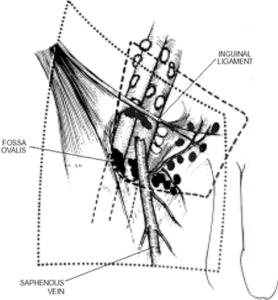A groin or inguinal dissection is an operation performed under a General Anaesthetic (going to sleep) which removes all of the lymph nodes (glands) in the groin. Occasionally the pelvic lymph nodes have to be removed as well through a slightly larger cut.

Groin Dissection
Lymph nodes are part of your immune system and are present throughout your body. Their job is to filter the liquid which naturally leaks out of blood vessels. This liquid (the lymph) travels to the nodes which contain lots of white blood cells designed to trap and fight germs which can cause infection. You may have felt swollen lymph nodes in your neck when you have had an infection such as a simple cold. As well as trapping germs, the lymph nodes can also trap cancer cells that have migrated from a primary tumour.
It is often not possible to tell how many nodes contain melanoma until after your operation. The nodes removed from the groin are carefully looked at under a microscope. Your doctor will have already felt your groin to see if there are any lumps and you will have had a special scan (CT or MRI) to look more closely at the nodes or had a sentinel node biopsy. Nodes can feel big if there is infection in the area, so if you can feel a lump in your groin it does not necessarily mean that the cancer has spread.
If there is only a small amount of cancer cells present in the nodes then the groin can feel normal and look normal on scan. This is often why we do not know if the cancer has spread to the nodes until they have been looked at under a microscope.
There are hundreds of lymph nodes throughout your body, which will still be there to fight infection after your operation, but you will be at increased risk of infection in the affected limb.
When do I need a Groin Dissection?
Groin dissection is performed when melanoma is found in lymph nodes by Sentinel Node Biopsy or by Fine Needle Aspiration Biopsy of enlarged nodes.
What are the potential side effects of Groin Dissection?
- bleeding (< 5%)
- infection (< 5%)
- seroma (10-15%)
- numbness around the scar (common)
- swelling of the leg or lymphoedema (10-15%)
What can I expect after the operation?
Your surgeon will inject local anaesthetic around the wound and chart painkillers although the wound is not usually very painful.
Post operative care includes a few nights in hospital with strict bed rest, this to reduce the amount of fluid that comes out of your drain. You will be given injections to prevent blood clots (DVT) in the legs and will probably have a urinary catheter placed to make life easier.
You will be discharged with a drain in the groin, which may stay for a few weeks. The district nurse will look after this and remove it when there is less than 20mls in the drain in 24 hours.
A special stocking can be fitted for the few people who develop problems with leg swelling (lymphoedema). Ongoing care must be had to avoid infection or injury in the leg, as this will make any swelling worse.
Postoperative treatment
It takes a week or more to look at the lymph nodes properly so your doctors will not know until then whether additional treatment is necessary. Any additional treatment usually involves radiotherapy or sometimes chemotherapy.
